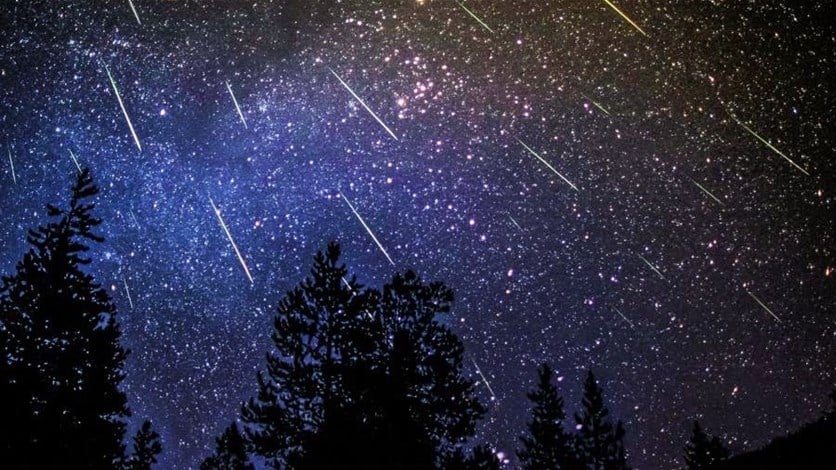
الشهب والنيازك , هل تحلمون برؤيتها ؟ إذا عليكم التوجه إلى اقرب مكان هادئ في الشرق الأوسط لمشاهدة السماء هناك تمطر الشهب والنيازك فهذه الفترة هي ذروة تساقط زخات شهب “البرشاويات” التي تظهر مرة واحدة في كل عام. وهذا العام بدأ ظهورها في 10 أغسطس/آب ويمتد حتى 14 من الشهر نسفه.
وأوضح عصام جودة، رئيس الجمعية المصرية لعلوم الفلك، أن زخات شهب البرشاويات هي إحدى أشهر الزخات الشهابية البراقة. وهي تتساقط مرة واحدة فقط من كل عام في نفس التوقيت، في شهر أغسطس/آب”
وشرح جودة أن “معدل سقوط شهب البرشاويات هو 70 شهابا في الساعة الواحدة. ومن الممكن أن تزيد النسبة عن هذا الرقم، خاصةً في يوم 12 أغسطس/آب الذي يُعتبر ذروة زخات البرشاويات التي تخترق الغلاف الجوي بمتوسط سرعة 60 كلم/الساعة، ولذا فهي تظهر على شكل شهب”.
كما أشار جودة إلى أن “سبب تسمية هذه الشهب باسم البرشاويات هو نسبةً إلى مجموعة برشاوس التي تعتبر إحدى المجموعات النجمية التي تأتي منها زخات الشهب. وتسقط هذه الشهب على الأرض من خلال دورانها حول الشمس في مسار مذنبات أو كويكبات قديمة تكون قد تركت بقاياها النيزكية في مسار دورانها حول الشمس. وحين تدخل هذه البقايا النيزكية التي يكون حجمها بحجم الحصى الصغيرة الغلاف الجوي تحترق في الطبقات العليا منه مما يتسبب في ظهور الزخات البرشاويات”.
وأكد جودة أنه يمكن رصد هذه الظاهرة بالعين المجردة. يُفضَّل رصد هذه الظاهرة بعيداً عن أضواء المدن، حيث إن الأماكن الجبلية والمناطق البعيدة عن المباني المرتفعة والمناطق السكانية هي الأفضل لمشاهدتها، حيث يتوقف وضوح الرؤية لهذه الشهب على مدى ظلام المنطقة التي يتم الرصد منها.
وتنطلق الشهب عادة من من نقطة واحدة في السماء ليلاً، هذه الشهب تنشأ عن تيارات من الحطام الكوني تدعى النيازك، والنيزك يمكن أن يكون جزيئات الغبار أو شظايا من المذنب أو كويكب حيث تدخل هذه النيازك الغلاف الجوي للأرض بسرعات عالية جداً وفي مسارات متوازية. معظم هذه النيازك اصغر من حبات الرمل ولذلك فكلها تقريباً يتفكك قبل أن يصل لسطح الأرض. وابل الشهب الكثيف يسمى بعاصفة الشهب أو انفجار الشهب والذي يمكن أن يولد أكثر من الف شهاب في الساعة الواحدة.مرات عديدة في السنة، ومئات من الكرات النارية السماوية تضيء السماء ليلا. قد يطلق عليهم اسم نجوم الرماية، لكنهم ليس لديهم أي علاقة فعلية بالنجوم. هذه الجسيمات الفضائية الصغيرة هي النيازك وهي حرفيا الحطام السماوية أو ما يسمى بالإنهمار النيزكي.
هي عبارة عن زخة عادية من الشهب وسميت بالبرشاويات لأنها – ظاهريا – كأنها تخرج من كوكبة برشاوش يعود سبب تزايد عدد الشهب في أيام معينة من العام إلى دخول الأرض أثناء حركتها المدارية حول الشمس ضمن منطقة مخلفات أحد المذنبات في أغلب الأحيان أو أحد الكويكبات في أحيان أخرى, حيث إن هذه المذنبات تدور حول الشمس وخلال هذه الدورات تخلف وراءها جسيمات صغيرة والتي تبقى سابحة في الفضاء ضمن مناطق معينة.
وإذا ما قطعت الأرض أثناء دورانها مدار أحد هذه الأجرام سواء أكانت مذنبات أم كويكبات فإن جاذبية الأرض ستؤثر على الجسيمات التي خلفتها هذه الأجرام مما يؤدي إلى دخول العديد منها إلى الغلاف الجوي الأرضي, وبما أن هذه الجسيمات موجودة بكثرة في هذه المناطق من الفضاء فهذا يؤدي إلى ظهور أعداد من الشهب أكثر من المعتاد في الأوقات الأخرى من العام، وهذا ما يدعى بالزخة الشهابية.
- Quadrantids
كوادرانتيدس هو أول انهمار نيزكي من كل عام، وعادة ما تحدث بين الأسبوع الأخير من ديسمبر كانون الثاني، و 12 يناير. وهو ذروته في جميع أنحاء 3 يناير و 4 يناير وينظر أفضل من نصف الكرة الشمالي. النقطة المشعة ل كوادرانتيدس يكمن في كوكبة بوتس، على مقربة من الدب الأكبر.
- Lyrids
نقطة مشع من ليريدز يكمن في كوكبة ليرا. هذا انهمار نيزكي يحدث بين 16 أبريل – 26 أبريل من كل عام ويمكن أن ينظر إليه من شمال وجنوب الكرة الأرضية.
- إيتا أكواريديس
ويحدث دش الشهب الرئيسي القادم، وهو ايتا أكواريدس ، بين أواخر نيسان / أبريل ومنتصف أيار / مايو، ويبلغ ذروته في الفترة ما بين 5 و 6 أيار / مايو. ومن الأفضل رؤيته من نصف الكرة الجنوبي، على الرغم من المراقبين في نصف الكرة الشمالي يمكن أيضا التمتع عرض متفرق. النيازك في إيكواريدس ايتا هي بقايا من المذنب هالي. لهذا يكمن في كوكبة الدلو.
- شهب البرشاويات
يحدث الانهمار النيزكي بيرسيد في منتصف أغسطس، لتصل إلى ذروة النشاط حوالي 11-13 أغسطس. نقطة مشع يكمن في كوكبة بيرسيوس ويرتبط مع المذنب سويفت توتل.






